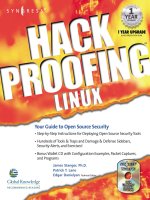hack proofing linux a Guide to Open Source Security phần 1 docx
Bạn đang xem bản rút gọn của tài liệu. Xem và tải ngay bản đầy đủ của tài liệu tại đây (4.11 MB, 66 trang )
James Stanger, Ph.D.
Patrick T. Lane
Edgar Danielyan
Technical Editor
™
1YEAR UPGRADE
BUYER PROTECTION PLAN
Your Guide to Open Source Security
• Step-by-Step Instructions for Deploying Open Source Security Tools
• Hundreds of Tools & Traps and Damage & Defense Sidebars,
Security Alerts, and Exercises!
• Bonus Wallet CD with Configuration Examples, Packet Captures,
and Programs
138_linux_FC 6/20/01 9:56 AM Page 1
With more than 1,500,000 copies of our MCSE, MCSD, CompTIA, and Cisco
study guides in print, we continue to look for ways we can better serve the
information needs of our readers. One way we do that is by listening.
Readers like yourself have been telling us they want an Internet-based ser-
vice that would extend and enhance the value of our books. Based on
reader feedback and our own strategic plan, we have created a Web site
that we hope will exceed your expectations.
is an interactive treasure trove of useful infor-
mation focusing on our book topics and related technologies. The site
offers the following features:
■
One-year warranty against content obsolescence due to vendor
product upgrades. You can access online updates for any affected
chapters.
■
“Ask the Author”™ customer query forms that enable you to post
questions to our authors and editors.
■
Exclusive monthly mailings in which our experts provide answers to
reader queries and clear explanations of complex material.
■
Regularly updated links to sites specially selected by our editors for
readers desiring additional reliable information on key topics.
Best of all, the book you’re now holding is your key to this amazing site.
Just go to www.syngress.com/solutions, and keep this book handy when
you register to verify your purchase.
Thank you for giving us the opportunity to serve your needs. And be sure
to let us know if there’s anything else we can do to help you get the max-
imum value from your investment. We’re listening.
www.syngress.com/solutions
138_linux_FM 6/20/01 9:29 AM Page i
138_linux_FM 6/20/01 9:29 AM Page ii
Linux:
A Guide to Open Source Security
™
1 YEAR UPGRADE
BUYER PROTECTION PLAN
Linux:
A Guide to Open Source Security
The Only Way to Stop a Hacker Is to Think Like One
James Stanger
Patrick T. Lane
138_linux_FM 6/20/01 9:29 AM Page iii
Syngress Publishing, Inc., the author(s), and any person or firm involved in the writing, editing, or production
(collectively “Makers”) of this book (“the Work”) do not guarantee or warrant the results to be obtained from
the Work.
There is no guarantee of any kind, expressed or implied, regarding the Work or its contents.The Work is sold
AS IS and WITHOUT WARRANTY. You may have other legal rights, which vary from state to state.
In no event will Makers be liable to you for damages, including any loss of profits, lost savings, or other inci-
dental or consequential damages arising out from the Work or its contents. Because some states do not allow
the exclusion or limitation of liability for consequential or incidental damages, the above limitation may not
apply to you.
You should always use reasonable care, including backup and other appropriate precautions, when working
with computers, networks, data, and files.
Syngress Media®, Syngress®, and “Career Advancement Through Skill Enhancement®,”are registered trademarks
of Syngress Media, Inc. “Ask the Author™,”“Ask the Author UPDATE™,”“Mission Critical™,” and “Hack
Proofing™” are trademarks of Syngress Publishing, Inc. Brands and product names mentioned in this book are
trademarks or service marks of their respective companies.
KEY SERIAL NUMBER
001 NFKA4UR934
002 DFTGEGHFG6
003 9456VMPDSP
004 MKC8EWR535
005 ZL94V343BB
006 AS56J89HGE
007 MJTY3D29H6
008 ADQW9UU6NN
009 5TGBXDQ7TN
010 KRF4W2F6P9
PUBLISHED BY
Syngress Publishing, Inc.
800 Hingham Street
Rockland, MA 02370
Hack Proofing Linux: A Guide to Open Source Security
Copyright © 2001 by Syngress Publishing, Inc. All rights reserved. Printed in the United States of America.
Except as permitted under the Copyright Act of 1976, no part of this publication may be reproduced or dis-
tributed in any form or by any means, or stored in a database or retrieval system, without the prior written
permission of the publisher, with the exception that the program listings may be entered, stored, and executed
in a computer system, but they may not be reproduced for publication.
Printed in the United States of America
1 2 3 4 5 6 7 8 9 0
ISBN: 1-928994-34-2
Technical Editors: Edgar Danielyan and Larry Karnis Freelance Editorial Manager: Maribeth Corona-Evans
Co-Publisher: Richard Kristof Cover Designer: Michael Kavish
Acquisitions Editor: Catherine B. Nolan Page Layout and Art by: Shannon Tozier
Developmental Editor: Kate Glennon Copy Editor: Beth A. Roberts and Darren Meiss
CD Production: Michael Donovan Indexer: Jennifer Coker
Distributed by Publishers Group West in the United States.
138_linux_FM 6/20/01 9:29 AM Page iv
v
Acknowledgments
v
We would like to acknowledge the following people for their kindness and support
in making this book possible.
Richard Kristof and Duncan Anderson of Global Knowledge, for their generous
access to the IT industry’s best courses, instructors, and training facilities.
Ralph Troupe, Rhonda St. John, and the team at Callisma for their invaluable insight
into the challenges of designing, deploying and supporting world-class enterprise
networks.
Karen Cross, Lance Tilford, Meaghan Cunningham, Kim Wylie, Harry Kirchner, Bill
Richter, Kevin Votel, and Kent Anderson of Publishers Group West for sharing their
incredible marketing experience and expertise.
Mary Ging, Caroline Hird, Simon Beale, Caroline Wheeler,Victoria Fuller, Jonathan
Bunkell, and Klaus Beran of Harcourt International for making certain that our
vision remains worldwide in scope.
Anneke Baeten, Annabel Dent, and Laurie Giles of Harcourt Australia for all their
help.
David Buckland,Wendi Wong, Daniel Loh, Marie Chieng, Lucy Chong, Leslie Lim,
Audrey Gan, Charlotte Chan, and Joseph Chan of Transquest Publishers for the
enthusiasm with which they receive our books.
Kwon Sung June at Acorn Publishing for his support.
Ethan Atkin at Cranbury International for his help in expanding the Syngress
program.
Joe Pisco, Helen Moyer, Paul Zanoli, Alan Steele, and the great folks at InterCity
Press for all their help.
Philip Allen at Brewer & Lord LLC for all his work and generosity.
138_linux_FM 6/20/01 9:29 AM Page v
138_linux_FM 6/20/01 9:29 AM Page vi
vii
Contributors
Patrick T. Lane (MCSE, MCP+I, MCT, Network+, i-Net+, CIW)
is a Content Architect for ProsoftTraining.com, a leading Internet skills
training and curriculum development company. He is the author of
more than 20 technical courses and is the Director of the CIW
Foundations and CIW Internetworking Professional series.While at
ProsoftTraining.com, Patrick helped create the Certified Internet
Webmaster (CIW) program and the i-Accelerate program for Intel,
Novell, and Microsoft professionals.
Patrick consults as a mail, news, FTP, and Web Administrator for sev-
eral organizations, including jCert Initiative Inc. and ProsoftTraining.com.
He is also a network security consultant and writer who specializes in
TCP/IP internetworking, LAN/WAN solutions, network and operating
system security, and the Linux and Windows NT/2000 platforms. He has
consulted for the University of Phoenix/Apollo Group, Novell, Intel,
NETg,WAVE technologies, KT Solutions, SmartForce, and Futurekids.
Patrick is a member of the CompTIA Network+ Advisory Committee,
and co-author of Syngress Publishing’s E-mail Virus Protection Handbook
(ISBN: 1-928994-23-7). His work has been published in eight languages
and he has been a featured speaker for the SmartForce Seminar Series on
E-Business, the Internet World PING Series on Internet Protocol version
6, and the Information Technology Association of America (ITAA). He
holds a master’s degree in education.
James Stanger (Ph.D., MCSE, MCT) directs the Linux, Security, and
Server Administrator certification tracks for ProsoftTraining.com. Since
receiving his Ph.D. in 1997, he has focused on auditing Internet servers
and writing courseware, books, and articles about administering and
securing Internet servers. James has consulted for IBM, Symantec, Evinci
138_linux_FM 6/20/01 9:29 AM Page vii
viii
(www.evinci.org), Pomeroy (www.pomeroy.com), Securify
(www.securify.com), Brigham Young University, and California State, San
Bernardino. He specializes in troubleshooting firewalls, intrusion detec-
tion, DNS, e-mail, and Web server implementations.
James was the Technical Editor of Syngress Publishing’s E-mail Virus
Protection Handbook (ISBN: 1-928994-23-7) and has been an instructional
designer of security and A+ courses for NetG,Thompson/WAVE
learning, and ComputerPREP.Active in the Linux community, James
sits on the Linux Professional Institute (www.lpi.org), SAIR
(www.linuxcertification.org), and CompTIA Linux+ (www.comptia.org)
advisory boards, each of which is dedicated to creating and maintaining
industry-respected certifications.As the Vice Chair of the Linux
Professional Institute (LPI) Advisory Council, he acts as liaison between
the LPI and companies such as IBM, Compaq, and Intel.
138_linux_FM 6/20/01 9:29 AM Page viii
ix
Technical Editors
Edgar Danielyan (CCNA) is a self-employed developer specializing in
GCC, X Window,Tcl/Tk, logic programming, Internet security, and
TCP/IP; as well as having with BSD, SVR4.2, FreeBSD, SCO, Solaris, and
UnixWare. He has a diploma in company law from the British Institute of
Legal Executives as well as a paralegal certificate from the University of
Southern Colorado. He is currently working as the Network
Administrator and Manager of a top-level Armenian domain. He has also
worked for the United Nations, the Ministry of Defense of the Republic
of Armenia, and Armenian national telephone companies and financial
institutions. Edgar speaks four languages, and is a member of ACM, IEEE
CS, USENIX, CIPS, ISOC, and IPG.
Larry Karnis (RHCE, Master ACE, CITP), is a Senior Consultant for
Application Enhancements, a Unix, Linux, and Internet consulting firm
located in Toronto, Canada. His first exposure to Unix was over 20 years
ago where he used Unix Version 6 while completing a bachelor’s degree
in computer science and mathematics. Larry deploys and manages Linux-
based solutions such as Web and file and print servers, and Linux firewalls.
138_linux_FM 6/20/01 9:29 AM Page ix
x
This book is accompanied by a CD containing files and open source programs used
throughout the book.The files include configuration examples, packet captures, and
additional resources.We have included the specific open source programs used in the
book so you can follow the chapter demonstrations step-by-step on your own systems.
Each file on the CD is discussed in detail and referenced throughout the book
with the CD icon below.When a specific file or program is required, it directs you to
the accompanying CD.The book also directs you to the Web site where you can
download the most current version, and find additional resources relating to that pro-
gram. For instance, you can download Free Secure Wide Area Network (FreeS/WAN)
at www.freeswan.org, or use the version located on the CD. It is recommended that
you use the version included on the CD because this will increase the chances that
the book demonstrations will be successful, as some of the programs may have
changed since this book was printed.
The book is written to Red Hat Linux 7.x.Therefore, most of the CD files are
Red Hat Package Manager (.rpm) files.There are also many Tape Archive (.tar) files
and GNU Zip (.gzip) files. Instructions for unpacking and installing these files are
included in their respective locations throughout the book.To mount the CD onto
your Linux system, you would issue the following command (for Red Hat systems):
mount -t iso9660 /dev/cdrom /mnt/cdrom
And to unmount:
umount /mnt/cdrom
It is recommended that you copy the CD files to your hard drive before working
with them. If you use other versions of Linux, you may need to modify the demon-
strations, or download a portable version of the open source programs to work with
your version of Linux.
Look for this CD icon when obtaining files used
in the book demonstrations.
About the CD
138_linux_FM 6/20/01 9:29 AM Page x
Contents
xi
Foreword xxvii
Chapter 1 Introduction to Open
Source Security 1
Introduction 2
The Tools Used in This Book 3
Using the GNU General Public License 3
Fee-Based GPL Software 5
Can I Use GPL Software in My Company? 5
Soft Skills: Coping with Open Source Quirks 6
General Lack of Installation and Configuration
Support 6
Infrequent or Irregular Update Schedules 6
Command-Line Dominance 6
Lack of Backward Compatibility and No
Regular Distribution Body 7
Inconvenient Upgrade Paths 7
Conflicts in Supporting Libraries and Limited
Platform Support 7
Interface Changes 8
Partially Developed Solutions 8
Should I Use an RPM or Tarballs? 10
Tarball 10
Red Hat Package Manager 11
Debian 11
Obtaining Open Source Software 12
SourceForge 12
Freshmeat 13
Packetstorm 14
Using the GNU
General Public License
The GNU General Public
License (GPL) is the basis
of the open source
movement. This license is
provided by the Gnu is
Not Unix (GNU)
organization, which
develops various software
packages. The most
important element of this
license is that instead of
protecting a particular
person or company, it
protects the software code
that creates the
application.
138_linux_ToC 6/20/01 9:27 AM Page xi
xii Contents
SecurityFocus 15
Is That Download Safe? 16
A Brief Encryption Review 16
Symmetric Key Encryption 17
Asymmetric Key Encryption 18
Public Key and Trust Relationships 19
One-Way Encryption 20
GNU Privacy Guard 21
Deploying GNU Privacy Guard 21
Skipping Public Key Verification 29
Using GPG to Verify Signatures on
Tarball Packages 30
Using Md5sum 30
Auditing Procedures 31
Locking Down Your Network Hosts 31
Securing Data across the Network 32
Protecting the Network Perimeter 33
Summary 35
Solutions Fast Track 35
Frequently Asked Questions 38
Chapter 2 Hardening the Operating
System 41
Introduction 42
Updating the Operating System 42
Red Hat Linux Errata and Update Service
Packages 42
Handling Maintenance Issues 43
Red Hat Linux Errata: Fixes and Advisories 44
Bug Fix Case Study 46
Manually Disabling Unnecessary Services
and Ports 47
Services to Disable 47
The xinetd.conf File 48
Locking Down Ports 50
Well-Known and Registered Ports 50
Determining Ports to Block 52
138_linux_ToC 6/20/01 9:27 AM Page xii
Contents xiii
Blocking Ports 53
Xinetd Services 53
Stand-Alone Services 54
Hardening the System with Bastille 55
Bastille Functions 55
Bastille Versions 63
Implementing Bastille 64
Undoing Bastille Changes 74
Controlling and Auditing Root Access with Sudo 77
System Requirements 79
The Sudo Command 79
Downloading Sudo 80
Installing Sudo 82
Configuring Sudo 86
Running Sudo 90
No Password 92
Sudo Logging 93
Managing Your Log Files 96
Using Logging Enhancers 97
SWATCH 97
Scanlogd 100
Syslogd-ng 101
Summary 103
Solutions Fast Track 104
Frequently Asked Questions 107
Chapter 3 System Scanning and Probing 109
Introduction 110
Scanning for Viruses Using the AntiVir Antiviru
Application 110
Understanding Linux Viruses 110
Using AntiVir 112
Key Mode and Non-Key Mode 114
Licensing AntiVir 114
Exercise: Updating AntiVir 114
Using TkAntivir 116
Required Libraries and Settings 117
Determining Which
Ports to Block
When determining which
ports to block on your
server, you must first
determine which services
you require. In most cases,
block all ports that are not
exclusively required by
these services. This is tricky,
because you can easily
block yourself from
services you need,
especially services that use
ephemeral ports. If your
server is an exclusive e-mail
server running SMTP and
IMAP, you can block all TCP
ports except ports 25 and
143, respectively. If your
server is an exclusive HTTP
server, you can block all
ports except TCP port 80.
138_linux_ToC 6/20/01 9:27 AM Page xiii
xiv Contents
Scanning Systems for Boot Sector and
E-Mail Viruses 117
Additional Information 120
Exercise: Using TkAntivir 120
Scanning Systems for DDoS Attack Software
Using a Zombie Zapper 123
How Zombies Work and How to Stop Them 124
When Should I Use a Zombie Zapper? 125
What Zombie Zapper Should I Use? 125
What Does Zombie Zapper Require
to Compile? 127
Exercise: Using Zombie Zapper 127
Scanning System Ports Using the Gnome Service
Scan Port Scanner 129
Required Libraries 130
Why Use a Port Scanner? 131
Exercise: Using Gnome Service Scanner 131
Using Nmap 133
Isn’t Nmap Just Another Port Scanner? 134
Acquiring and Installing Nmap 136
Common Nmap Options 136
Applied Examples 137
Scanning Entire Networks and Subnets 138
Selective Scanning 139
Adding More Stealth 139
Saving to Text and Reading from Text 140
Testing Firewalls and Intrusion Detection
Systems 141
Example: Spoofing the Source Address
of a Scan 142
Timing Your Scan Speeds 142
Example: Conducting a Paranoid Scan 143
Exercise: Using Nmap 143
Using Nmap in Interactive Mode 144
Exercise: Using Nmap in Interactive
Mode 144
Learn How to Set
Preferences For
TkAntivir
138_linux_ToC 6/20/01 9:27 AM Page xiv
Contents xv
Using NmapFE as a Graphical Front End 146
Exercise: Using NmapFE 147
Using Remote Nmap (Rnmap) as a Central
Scanning Device 147
Exercise: Scanning Systems with Rnmap 148
Deploying Cheops to Monitor Your Network 151
How Cheops Works 153
Obtaining Cheops 154
Required Libraries 154
The Cheops Interface 155
Mapping Relations between Computers 157
Cheops Monitoring Methods 157
Connectivity Features 159
Exercise: Installing and Configuring
Cheops 160
Deploying Nessus to Test Daemon Security 165
The Nessus Client/Server Relationship 167
Windows Nessus Clients 169
Required Libraries 169
Order of Installation 170
Configuring Plug-Ins 173
Creating a New Nessus User 174
The Rules Database 174
Exercise: Installing Nessus and
Conducting a Vulnerability Scan 175
Updating Nessus 179
Understanding Differential, Detached,
and Continuous Scans 180
Exercise: Conducting Detached
and Differential Scans with Nessus 182
Summary 185
Solutions Fast Track 185
Frequently Asked Questions 189
138_linux_ToC 6/20/01 9:27 AM Page xv
xvi Contents
Chapter 4 Implementing an
Intrusion Detection System 191
Introduction 192
Understanding IDS Strategies and Types 194
IDS Types 195
Host-Based IDS Applications 196
Network-Based IDS Applications 196
IDS Applications and Fault Tolerance 197
What Can an IDS Do for Me? 200
Which IDS Strategy Is Best? 203
Network-Based IDS Applications and
Firewalls 203
IDS Applications 204
Installing Tripwire to Detect File Changes on
Your Operating System 206
Tripwire Dependencies 207
Availability 208
Deploying Tripwire 208
Tripwire Files 208
Tripwire Installation Steps 209
Configuring the Tripwire Policy File 209
Creating the Tripwire Policy File 212
Database Initialization Mode 212
Testing E-Mail Capability 214
Integrity Checking Mode 214
Specifying a Different Database 215
Reading Reports 215
Updating Tripwire to Account for Legitimate
Changes in the OS 215
Updating the Policy 216
What Do I Do if I Find a Discrepancy? 217
Configuring Tripwire to Inform You Concerning
Changes 217
Exercise: Installing Tripwire 217
Exercise: Securing the Tripwire Database 219
Exercise: Using Cron to Run Tripwire
Automatically 220
SECURITY ALERT!
Although Tripwire has a
“file integrity mode,”
Tripwire is not really an
integrity checker in the
classic sense. It does
not, for example, test
the file’s stability or
inode number or any
other aspect in regards
to file storage. Tripwire
simply compares a file’s
new signature with
that taken when the
database was created.
Other tools may be
used to check the
integrity of a file’s per-
missions and ownership
information.
138_linux_ToC 6/20/01 9:27 AM Page xvi
Contents xvii
Deploying PortSentry to Act as a
Host-Based IDS 220
Important PortSentry Files 221
Installing PortSentry 222
Configuring PortSentry to Block Users 222
Optimizing PortSentry to Sense Attack Types 223
Exercise: Installing and Configuring
PortSentry 224
Exercise: Clearing Ipchains Rules 227
Exercise: Running an External Command
Using PortSentry 227
Installing and Configuring Snort 229
Availability 229
Supporting Libraries 229
Understanding Snort Rules 230
Snort Variables 230
Snort Files and Directories 231
Snort Plug-Ins 232
Starting Snort 233
Logging Snort Entries 236
Running Snort as a Network-Based IDS 236
Ignoring Hosts 237
Additional Logging Options:Text
files,Tcpdump, and Databases 237
Configuring Snort to Log to a Database 238
Controlling Logging and Alerts 239
Getting Information 240
Exercise: Installing Snort 240
Exercise: Using Snort as an IDS
Application 241
Exercise: Configuring Snort to Log to
a Database 243
Exercise: Querying a Snort Database
from a Remote Host 251
Identifying Snort Add-Ons 251
SnortSnarf 252
138_linux_ToC 6/20/01 9:27 AM Page xvii
xviii Contents
Exercise: Using SnortSnarf to Read
Snort Logs 252
Analysis Console for Intrusion Databases 252
Summary 254
Solutions Fast Track 254
Frequently Asked Questions 258
Chapter 5 Troubleshooting the
Network with Sniffers 261
Introduction 262
Understanding Packet Analysis and TCP
Handshakes 264
TCP Handshakes 265
Establishing a TCP Connection 265
Terminating a TCP Connection 266
Creating Filters Using Tcpdump 268
Tcpdump Options 268
Tcpdump Expressions 271
Boolean Operators 275
Installing and Using Tcpdump 276
Configuring Ethereal to Capture Network
Packets 279
Ethereal Options 281
Ethereal Filters 283
Configuring Ethereal and Capturing Packets 283
Viewing Network Traffic between Hosts Using
EtherApe 288
Configuring EtherApe and Viewing Network
Traffic 289
Summary 293
Solutions Fast Track 294
Frequently Asked Questions 296
Chapter 6 Network Authentication
and Encryption 299
Introduction 300
Understanding Network Authentication 300
Learn the Flags Used
in TCP Connections
Flag Description
SYN Synchronize
sequence
numbers. Used for
connection
establishment.
FIN The sender is
finished with the
connection. Used
for connection
termination.
RST Reset the
connection.
PSH Push the data.
ACK Acknowledgment
URG Urgent
138_linux_ToC 6/20/01 9:27 AM Page xviii
Contents xix
Attacking Encrypted Protocols 301
Creating Authentication and Encryption
Solutions 303
Implementing One-Time Passwords
(OTP and OPIE) 305
What Files Does OPIE Replace? 305
How Does OPIE Work? 305
OPIE Files and Applications 306
opiepasswd 307
Password Format 308
Using opiekey 309
Using opieinfo and opiekey to Generate
a List 310
Installing OPIE 310
Configuration Options 310
Installation Options 311
Uninstalling OPIE 312
Exercise: Installing OPIE 312
Exercise: Installing the OPIE Client
on a Remote Server 315
Exercise: Using opie-tk and Allowing
Windows Users to Deploy OPIE. 316
Exercise: Installing opieftpd 318
Implementing Kerberos Version 5 319
Why Is Kerberos Such a Big Deal? 320
Kerberos Terms 321
Kerberos Principals 322
The Kerberos Authentication Process 323
How Information Traverses the Network 324
Creating the Kerberos Database 325
Using kadmin.local 325
Using kadmin 326
Using kadmin on the Client 328
Using kadmin and Creating Kerberos Client
Passwords 329
Setting Policies 330
Using Kinit 330
Answer Your
Questions about
Kerberos
Q: I wish to remove a
principal from the
keytab of one of my
Kerberos clients. How
do I do this?
A: Enter kadmin as an
administrative user on
the Kerberos client
(not the KDC) and use
the ketremove option.
For example, if you
wanted to remove the
principal for the user
named james, you
would do the
following:
terminal$/usr/
kerberos/sbin/kadmin
kadmin: ktremove
–p james
kadmin: quit
terminal$
138_linux_ToC 6/20/01 9:27 AM Page xix
xx Contents
The kinit Command and Time Limits 332
Managing Kerberos Client Credentials 333
The kdestroy Command 333
Exercise: Configuring a KDC 334
Establishing Kerberos Client Trust Relationships
with kadmin 337
Additional Daemon Principal Names 339
Logging On to a Kerberos Host Daemon 340
Common Kerberos Client Troubleshooting
Issues and Solutions 340
Kerberos Client Applications 341
Kerberos Authentication and klogin 342
Exercise: Configuring a Kerberos Client 342
Summary 345
Solutions Fast Track 345
Frequently Asked Questions 348
Chapter 7 Avoiding Sniffing
Attacks through Encryption 353
Introduction 354
Understanding Network Encryption 354
Capturing and Analyzing Unencrypted
Network Traffic 355
Using OpenSSH to Encrypt Network Traffic
between Two Hosts 361
The OpenSSH Suite 362
Installing OpenSSH 364
Configuring SSH 367
How SSH Works 368
Insecure r-command Authentication 368
Secure SSH Authentication 371
Implementing SSH to Secure Data Transmissions
over an Insecure Network 373
Distributing the Public Key 376
Capturing and Analyzing Encyrpted Network
Traffic 381
Summary 385
Secure E-Commerce
Transactions
If hackers were alerted to
an unsecure server, they
could capture packets
going in and out of the
server to gain the data
they sought. For example,
if an e-commerce server
does not use any type of
network encryption for
transactions, there is a
great deal of data to be
gained by a hacker.
Unfortunately, many small
companies or
entrepreneurs set up their
own Web servers,
unaware of potential
security problems, and set
up simple scripts to
process payment forms.
138_linux_ToC 6/20/01 9:27 AM Page xx
Contents xxi
Solutions Fast Track 386
Frequently Asked Questions 388
Chapter 8 Creating Virtual Private
Networks 391
Introduction 392
Secure Tunneling with VPNs 392
Telecommuter VPN Solution 392
Router-to-Router VPN Solution 394
Host-to-Host VPN Solution 395
Tunneling Protocols 395
Explaining the IP Security Architecture 396
Using IPSec with a VPN Tunneling Protocol 400
Internet Key Exchange Protocol 401
Creating a VPN by Using FreeS/WAN 402
Downloading and Unpacking FreeS/WAN 404
Compiling the Kernel to Run FreeS/WAN 407
Recompiling FreeS/WAN into the New
Kernel 417
Configuring FreeS/WAN 420
Testing IP Networking 420
Configuring Public Key Encryption for
Secure Authentication of VPN
Endpoints 424
Starting the Tunnel 434
Capturing VPN Tunnel Traffic 436
Closing the VPN Tunnel 438
Summary 439
Solutions Fast Track 440
Frequently Asked Questions 441
Chapter 9 Implementing a Firewall
with Ipchains and Iptables 445
Introduction 446
Understanding the Need for a Firewall 447
Building a Personal Firewall 449
Understanding Packet Filtering
Terminology 450
Secure Tunneling with
Virtual Private
Networks (VPNs)
VPNs provide a private
data network over public
telecommunication
infrastructures, such as
the Internet, by providing
authentication and
encryption through a data
“tunnel” between devices.
All data transmitted
between the devices
through the tunnel is
secure, regardless of what
programs the devices are
running.
138_linux_ToC 6/20/01 9:27 AM Page xxi
xxii Contents
Choosing a Linux Firewall Machine 452
Protecting the Firewall 452
Deploying IP Forwarding and Masquerading 453
Masquerading 456
Configuring Your Firewall to Filter Network
Packets 458
Configuring the Kernel 460
Packet Accounting 460
Understanding Tables and Chains in a Linux
Firewall 461
Built-In Targets and User-Defined Chains 462
Specifying Interfaces 463
Setting Policies 464
Using Ipchains to Masquerade Connections 467
Iptables Masquerading Modules 468
Using Iptables to Masquerade Connections 468
Iptables Modules 470
Exercise: Masquerading Connections
Using Ipchains or Iptables 471
Logging Packets at the Firewall 471
Setting Log Limits 472
Adding and Removing Packet Filtering Rules 472
ICMP Types 473
Exercise: Creating a Personal Firewall
and Creating a User-Defined Chain 475
Redirecting Ports in Ipchains and Iptables 477
Configuring a Firewall 478
Setting a Proper Foundation 478
Creating Anti-Spoofing Rules 479
Counting Bandwidth Usage 483
Listing and Resetting Counters 484
Setting Type of Service (ToS) in a Linux
Router 484
Setting ToS Values in Ipchains and Iptables 486
Using and Obtaining Automated Firewall Scripts
and Graphical Firewall Utilities 488
Understand Essential
Linux Firewall
Functions
■
IP address conservation
and traffic forwarding
■
Network differentiation
■
Protection against
denial-of-service,
scanning, and sniffing
attacks
■
IP and port
■
Content filtering
■
Packet redirection
■
Enhanced
authentication and
encryption
■
Supplemented logging
138_linux_ToC 6/20/01 9:27 AM Page xxii
Contents xxiii
Firewall Works in Progress 490
Exercise: Using Firestarter to Create a
Personal Firewall 490
Exercise: Using Advanced Firestarter
Features 498
Summary 500
Solutions Fast Track 500
Frequently Asked Questions 505
Chapter 10 Deploying the Squid
Web Proxy Cache Server 507
Introduction 508
Benefits of Proxy Server Implementation 508
Proxy Caching 508
Network Address Translation 510
Differentiating between a Packet Filter and
a Proxy Server 512
Implementing the Squid Web Proxy
Cache Server 513
System Requirements Specific to Proxy
Caching 516
Installing Squid 517
Configuring Squid 520
The http_port Tag 522
The Cache_dir Tag 523
The acl Tag 525
The http_access Tag 526
Starting and Testing Squid 528
Configuring Proxy Clients 529
Configuring Netscape Navigator and Lynx 530
Configuring Netscape Navigator 530
Configuring Lynx 532
Configuring Internet Explorer (Optional) 533
Summary 535
Solutions Fast Track 536
Frequently Asked Questions 538
Configure Squid
with the /etc/squid/
squid.conf file
138_linux_ToC 6/20/01 9:27 AM Page xxiii
xxiv Contents
Chapter 11 Maintaining Firewalls 543
Introduction 544
Testing Firewalls 544
IP Spoofing 546
Open Ports/Daemons 546
Monitoring System Hard Drives, RAM,
and Processors 547
Suspicious Users, Logins, and Login
Times 547
Check the Rules Database 548
Verify Connectivity with Company
Management and End Users 548
Remain Informed Concerning the
Operating System 549
Port Scans 549
Using Telnet, Ipchains, Netcat, and SendIP to
Probe Your Firewall 550
Ipchains 551
Telnet 551
Using Multiple Terminals 552
Netcat 552
Sample Netcat Commands 554
Additional Netcat Commands 555
Exercise: Using Netcat 557
SendIP:The Packet Forger 558
SendIP Syntax 558
Exercise: Using SendIP to Probe a
Firewall 560
Understanding Firewall Logging, Blocking, and
Alert Options 563
Firewall Log Daemon 563
Obtaining Firelogd 563
Syntax and Configuration Options 563
Message Format 564
Customizing Messages 566
Reading Log Files Generated by Other
Firewalls 568
See How to Use the
Firelogd Program
Firelogd (Firewall Log
Daemon) is a relatively
simple program that can
either be run as an
application or (you might
have guessed) as a
daemon. It does two
things:
■
It reads the kernel log
entries and passes
them into a "first in,
first out" (FIFO) pipe,
which Firelogd can
then process.
■
Once its buffer is full, it
e-mails a report of
suspicious traffic to an
account of your
choosing. You can have
it mailed to a local
account, or to a
remote system of your
choice.
138_linux_ToC 6/20/01 9:27 AM Page xxiv









